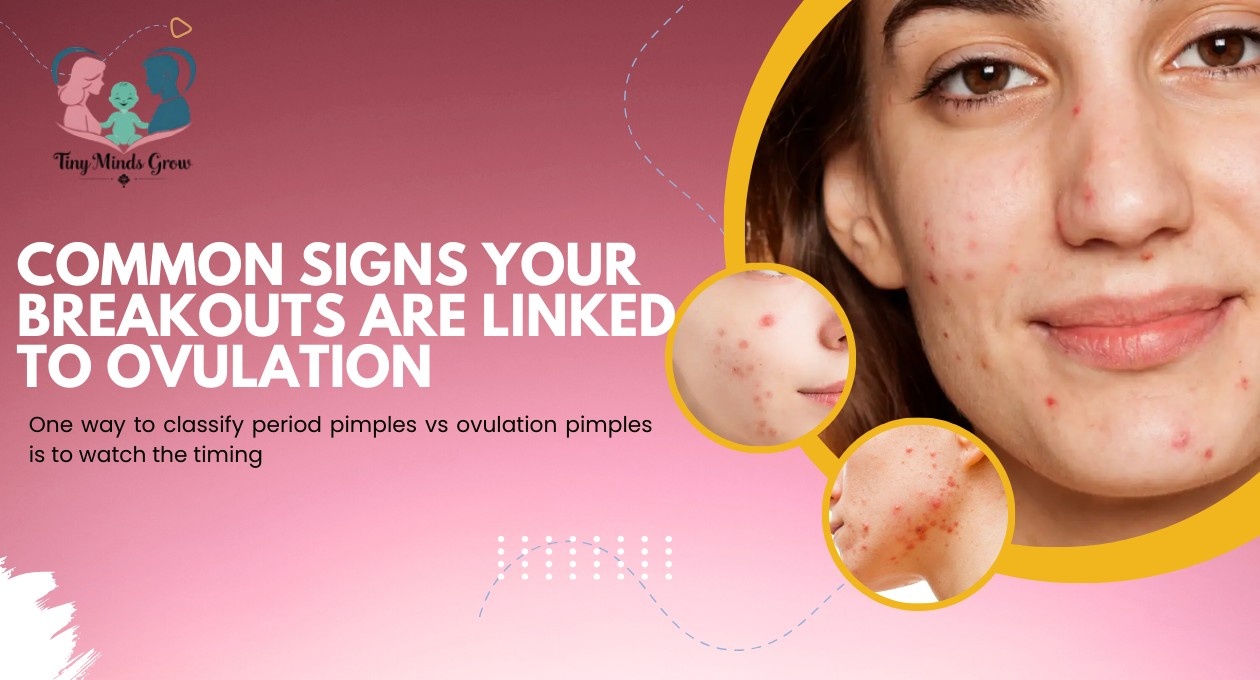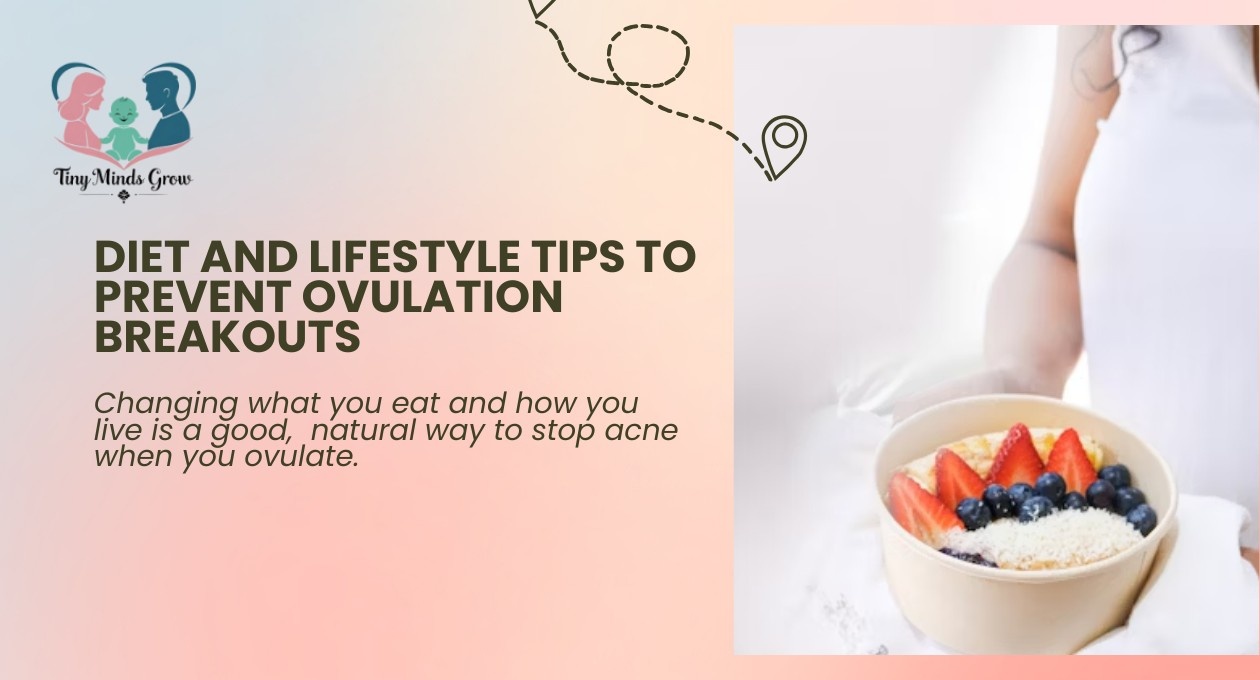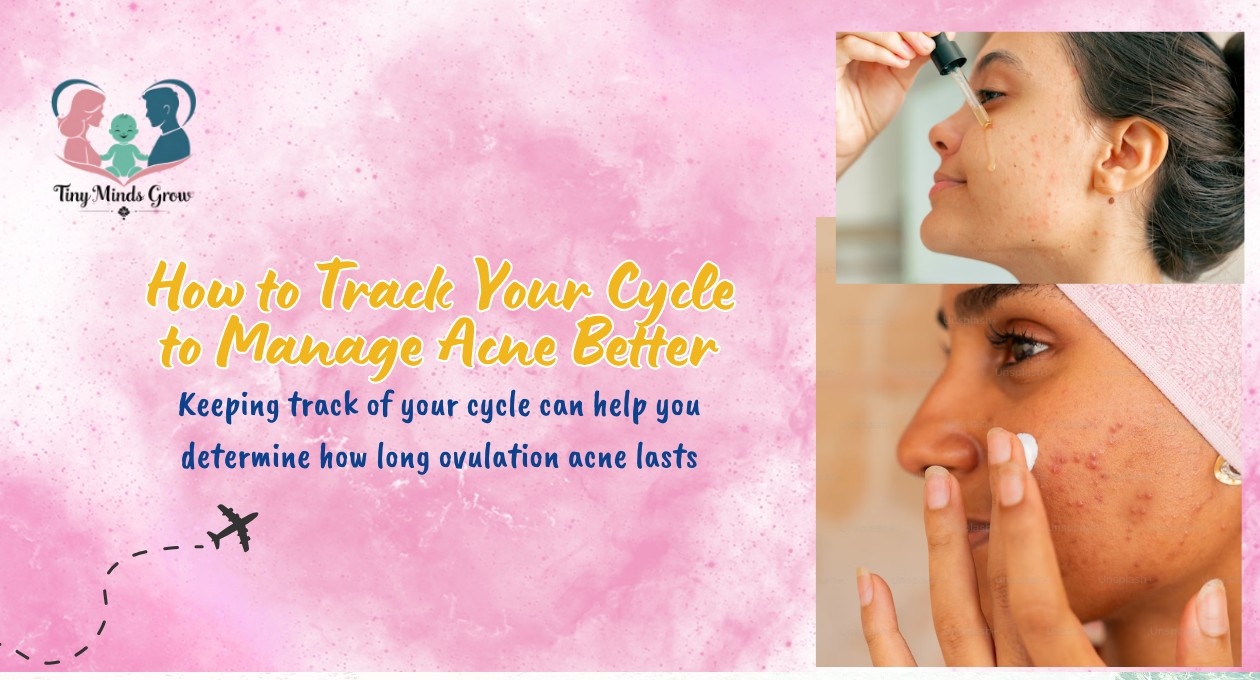Introduction to Acne During Ovulation
Many women in the USA know hormonal acne during ovulation without fully understanding why it happens. These mid-cycle breakouts can be annoying, especially when they seem at the same time each month. The skin reacts to hormonal changes that occur during the ovulation phase of the menstrual cycle, leading to obvious ovulation skin changes. These variations can include extra oil production, clogged pores, and deeper pimples linked to the ones you get before your period.
At tinymindsgrow.com, we often get questions from women who struggle with monthly menstrual cycle acne. The difference between period pimples vs ovulation pimples. Although both are due to hormonal changes, hormones are at their highest during ovulation acne, so it tends to be more inflammatory. Knowing these patterns is the first step in avoiding backdoor escape hatches and having true skin-confidence.
What type of Changes Occur to Your Body During Ovulation?
As you get older, the menstrual cycle begins. It moves from the follicular stage, to ovulation, the luteal stage, and ends with menstruation. Each woman’s cycle length is her own, but ovulation often takes place in the middle of the cycle. It usually falls on day 14 of a 28-day cycle. Hormones are changing right now, and the skin will be affected by these changes. When ovulation commences, estrogen levels and skin health are at their highest, giving a normal glow on skin.
Soon after, progesterone and acne become linked. Progesterone levels rise, causing oil to become thicker. This can trap filth and dead skin in the pores. For some women, does ovulation cause oily skin is not just a question — it’s a pure observation. Oily skin during this time is regular but can lead to ovulation pimples on chin and jawline acne hormonally if not achieved well.
Why Acne During Ovulation Happens: Hormonal Changes Explained
Many women ask why I get acne during ovulation when they sign the same pattern every month: oil to thicken and pores to tighten. This traps bacteria and debris inside the skin. The cause lies in how estrogen, progesterone, and testosterone change during ovulation. Before ovulation, estrogen keeps the skin even and balanced. After ovulation, estrogen globules and progesterone rise, causing at the same time, testosterone slightly increases.
This small alteration in androgens can trigger cystic acne mid cycle because it kindles oil glands. The result is often painful reactions that do not heal quickly. If you are already prone to oily skin, these shifts can lead to bigger acne flare-ups during luteal phase and degrade cycle-related skin problems before your period even starts.
Common Signs Your Breakouts Are Linked to Ovulation
One way to classify period pimples vs ovulation pimples is to watch the timing. Ovulation acne usually looks about 10–14 days before your period and fades as menstruation begins. If your breakouts ensue during this time every month, they are most likely linked to ovulation. The location and type of pimples can also give you clues.
Jawline acne hormonal and ovulation pimples on the chin are very common. You may also poster them on your cheeks or around your mouth. These pimples are mostly deeper, more painful, and take longer to cure than steady surface spots. They may also feel pain to the touch and be hardy to over-the-counter creams.

Risk Factors That Make Ovulation Acne Worse
Some things can make acne worse. In a diet, eating a lot of sugar, snacks, and dairy may lead to more hormone-based changes on our skin like acne and redness. Stress raises cortisol, throwing off hormone balance and making acne worse. Not sleeping enough ups oil make and drops the skin’s fix power.
Using rough soaps or skipping lotion hurts the skin’s guard, making it oilier. In big US cities, things like wet air and dirt can also add to skin problems tied to cycles, mostly during hormone shifts in ovulation.
Natural Therapies for Acne During Ovulation
If you are looking for how to stop acne during ovulation naturally, start with gentle treatments. Aloe vera gel can reduce redness and swelling. Honey masks can fight bacteria and help the casing cure faster. These are safe, and natural steps for sensitive skin. Other natural remedies for mid-cycle pimples include taking green tea or spearmint tea, which may help to regulate hormones.
Adding anti-inflammatory foods in a diet like salmon, turmeric, and spinach can also make a difference. These ovulation acne home treatment methods are effective for many females who want to avoid strong chemicals.
Diet and Lifestyle Tips to Prevent Ovulation Breakouts
Changing what you eat and how you live is a good, natural way to stop acne when you ovulate. Stay healthy by eating fewer fat meats, fresh greens, whole grains, and good fats. You can also lower swelling by not having sweet drinks and fried foods, which can cause pimples. Working out helps keep your hormones in line for clear skin and helps with reducing stress.

Drinking lots of water helps clear out bad stuff from your body. Deep breaths and calming acts like deep thought can lower stress and make your skin better. Over time, these moves can really help you handle ovulation acne well.
| Food That Support Clear Skin | Foods That Can Trigger Acne |
| Spinach and kale | Sugary snacks |
| Salmon and tuna | Processed meats |
| Almonds and walnuts | White bread |
| Berries | Fried fast |
| Green tea | Full-fat dairy |
Medical Treatment Options for Severe Ovulation Acne
If natural methods do not control your acne, medical conduct may assist. If you have cystic acne mid cycle that is painful or leaves scars, see a dermatologist. They can create a plan that can be based on your skin type and hormone levels. Prescription treatments may include retinoid creams, benzoyl peroxide, or antibiotics for inflammation.
Some women use birth control pills or spironolactone to accomplish what hormones cause ovulation acne. These are often considered when ovulation acne home treatment is not enough, and acne affects confidence or daily life.
How to Track Your Cycle to Manage Acne Better
Keeping track of your cycle can help you determine how long ovulation acne lasts. Ovulation acne often stays for 5-7 days for women, but it may change. You can guess the days of your period that may bring acne by using apps like Flo, Clue, or Glow. So, putting together the best skincare plan for ovulation acne is a lot easier this way.

During your ovulation window, you can concentrate on deep cleansing, avoid wearing a lot of makeup, and switch to relaxing items. During the menstrual cycle, according to skincare recommendations can help prevent pimples from developing in the first place.
FAQs
Can only skincare prevent hormonal acne during ovulation?
While skincare can certainly help us, if the hormonal acne is due to ovulation, nothing except for a regular menstruation cycle will completely stop the breakouts. But the most important will likely be to combine gentle skincare with making some changes to your lifestyle and diet.
Is ovulation acne more common in certain age groups?
You see it more with women in their 20s and 30s mid-cycle breakouts because they still have very high hormone fluctuation. But, it can also hit teenagers and women in perimenopause.
Can I get ovulation acne if my cycle is irregular?
Yes. Pimples can result from hormonal changes and ovulation skin changes as your body gets ready for potential ovulation, even if it doesn’t occur every month.
What’s the fastest natural remedy for ovulation pimples?
Try using ice to minimize swelling and applying raw honey to combat bacteria for immediate relief. Many women find that these natural solutions for mid-cycle pimples resolve within 24 to 48 hours.
Should I see a doctor for jawline acne hormonal during ovulation?
Yes,you have to visit if it’s severe and leaves scars. A dermatologist can recommend treatments based on your hormone profile and cycle-related to your skin problems.
Final Thought
The difference between ovulation acne and PMS acne comes down to judgment and hormone patterns. Ovulation acne appears mid-cycle, begun by high progesterone and testosterone, while PMS acne occurs right before your period due to falling estrogen.
At tinymindsgrow.com, we encourage women to understand their cycle-related skin problems and work with their bodies. Starting with preventing acne during ovulation naturally is often the best approach. If needed, then professional treatments are available. By combining self-care, healthy habits, and awareness, you could enjoy clearer skin and more self-confidence every month.
For more amazing blogs keep visiting TinyMindsGrow.

